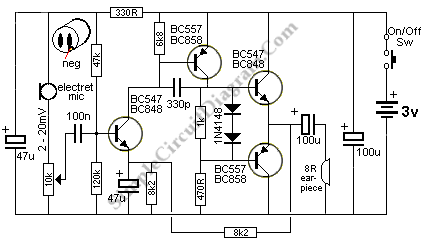Small Amplifier Using Transistors
The output of this circuit is push-pull and consumes less than 3mA (with no signal) but drives the earpiece to a very loud level when audio is detected. Because the whole circuit is Dc coupled, its extremely difficult to set up.

Basically you don’t know where to start with the biasing. 8k2 between the emitter of the first transistor and 0v rail and the 470R resistor are two most critical components. The 8k2 across the 47u sets the emitter voltage on the BC 547 and this turns it on. Then, the collector is directly connected to the base of a BC 557, called the driver transistor. The output of the BC557 causes current to flow through the 1k and 470R resistors so that the voltage developed across each resistor turns on the two output transistors since both of transistor are turned on. Mid-rail voltage on the join of the two emitters is the end of the result. Major negative feedback is provided by the 8k2 feedback resistor while the 330p prevents high-frequency oscillations occurring. [Source: talkingelectronics.com]